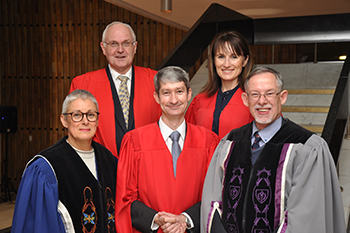UFS professor addresses genetically modified food in South Africa in inaugural lecture

At the inaugural lecture were, from the left front,
Prof Lis Lange, Vice Rector: Academic;
Prof Chris Viljoen; Prof Gert van Zyl,
Dean: Faculty of Health Sciences; back: Prof Marius Coetzee,
Head of Department of Haematology and Cell Biology;
and Dr Lynette van der Merwe, Undergraduate
Programme Director.
Photo: Stephen Collett
The first genetically modified (GM) crops in South Africa were planted in 1998. Eighteen years later, the country is one of the largest producers of GM food in the world. Those in support of genetically modified crops say this process is the only way to feed a rapidly growing world population. But those who criticise GM food describe it as a threat to the environment and safety of the population. Who is right? According to Prof Chris Viljoen of the Department of Haematology and Cell Biology at the University of the Free State, neither position is well-founded.
GM crops play a vital role in food security
While GM crops have an important role to play in increasing food production, the technology is only part of the solution to providing sufficient food for a growing world population. The major genetically modified crops produced in the world include soybean, cotton, maize and canola. However, the authenticity of food labelling and the long-term safety of GM food are issues that consumers are concerned about.
Safety and labelling of GM food important in South Africa
In his inaugural lecture on the subject “Are you really going to eat that?” Prof Viljoen addressed the importance of the safety and labelling of GM food in the country. “In order for food to be sustainable, production needs to be economically and environmentally sustainable. On the other hand, food integrity, including food quality, authenticity and safety need to be ensured,” Prof Viljoen said.
Labelling of food products for genetic modification was mandatory in South Africa, he went on to say. “It allows consumers the right of choice whether to eat genetically modified foods or not.” The Consumer Protection Act of 2008 requires food ingredients containing more than 5% of GM content to be labelled.
GMO Testing Facility world leader in food diagnostic testing
In 1999, Prof Viljoen spearheaded research in developing a GM diagnostic testing platform, and in 2003, a commercial diagnostic platform for GM status certification, called the GMO Testing Facility, was founded. The facility is a licensed Eurofins GeneScan laboratory a world leader in food diagnostic testing and provides diagnostic detection and quantification of genetically modified organisms (GMOs) in grain and processed foods for the local and international market.
Molecular diagnostic technology the future of food integrity, authenticity and safety
With GM labelling now well-established in South Africa, the next challenge is to establish the use of molecular diagnostic technology to ensure that food integrity, including food authenticity and safety is maintained, said Prof Viljoen.
“To the question ‘Are you really going to eat that?’ the answer is ‘yes’, but let’s continue doing research to make sure that what we eat is safe and authentic.”